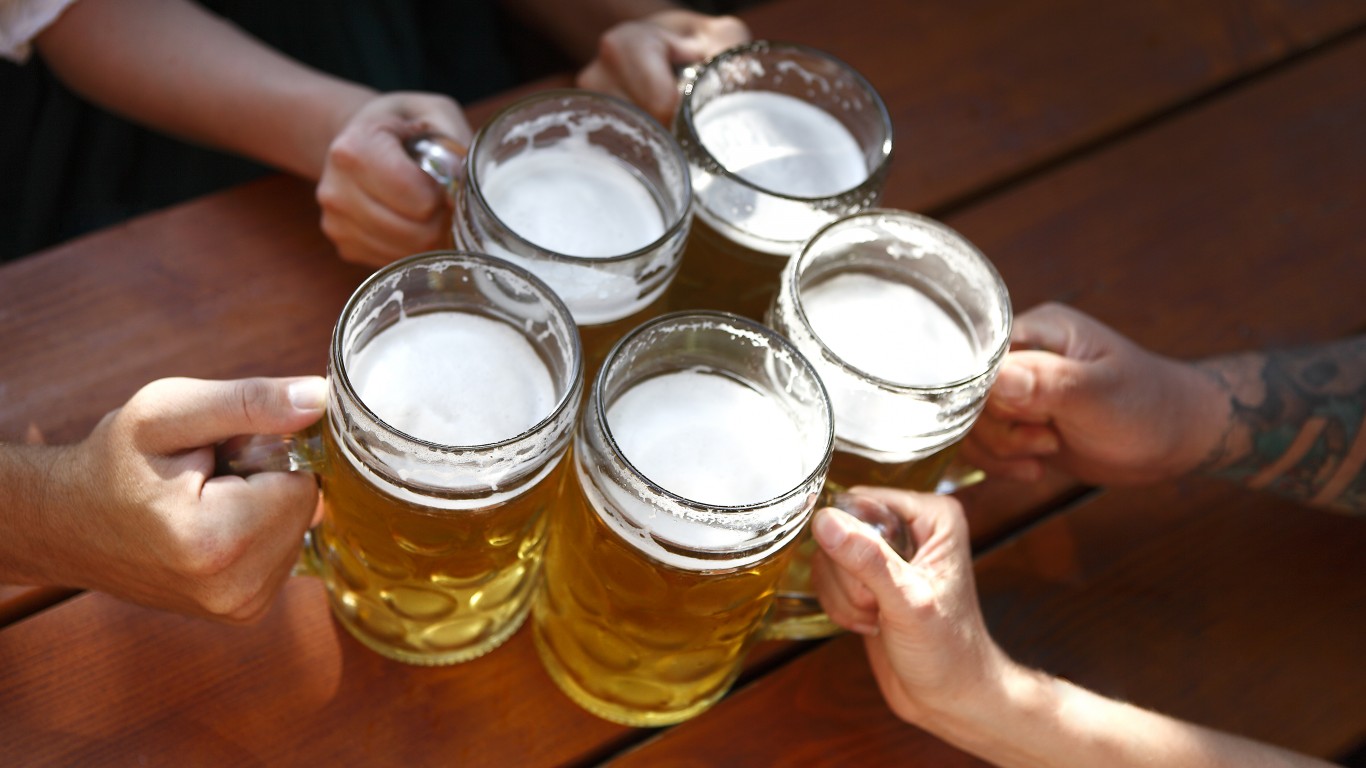
Everybody talks about craft beer these days, but what people mostly drink is the mass-produced, distinctly non-craft stuff.
Sales of specialty brews are definitely rising: The nation’s 7,500-plus craft breweries shipped a total of 25.9 million barrels in 2018, up from 9.1 million just 10 years earlier. Out of those, these are the 35 most popular craft breweries in America.
If the amount of craft beer sold sounds impressive, consider that the nation’s No. 1 beer brand, Bud Light, alone shipped 27.2 million barrels last year — and sales of the top three brands (all of them, incidentally, light or “lite”) exceeded 53 million.
24/7 Tempo reviewed domestic shipping volume data provided by industry advocacy group Beer Marketer’s Insights to determine America’s biggest beer brands in terms of 2019 sales volume.
The results reveal that we like drinking American brands: Only six of the nation’s 25 top-selling beers last year were imported. It also reminds us that two massive companies absolutely dominate the beer market: 18 of the 25 top selling beers — including the top five, and eight of the top 10 — were produced under the corporate umbrellas of either Anheuser-Busch InBev or Molson Coors.
Click here to see the most popular beer brands in America.
Click here to see our detailed findings and methodology.
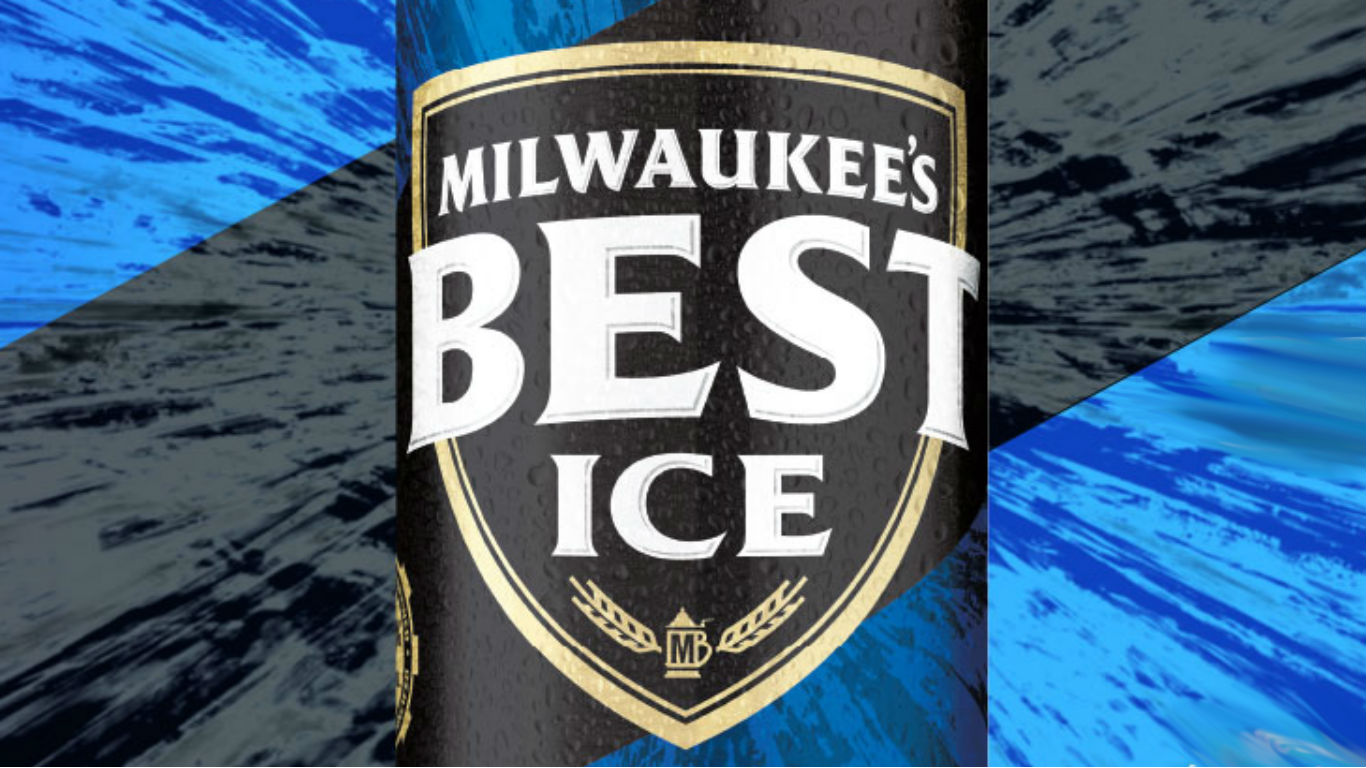
25. Milwakuee’s Best Ice
> Parent company: Molson Coors Brewing Company
> Barrels shipped in 2019: 1.1 million
> Shipment change from 2018: -5.4%
> Market share: 0.51%
“Old Milwaukee’s Best is my best friend,” Texas singer-songwriter Adam Carroll once claimed. The brand’s ice beer version probably would have been particularly attractive to him. Ice beers are chilled to a low enough temperature after brewing so that ice crystals form. The crystals are then removed, which slightly increases the beer’s ABV. (It removes some of the water that was diluting the alcohol.) The process is also said to make the brew smoother and richer.
[in-text-ad]
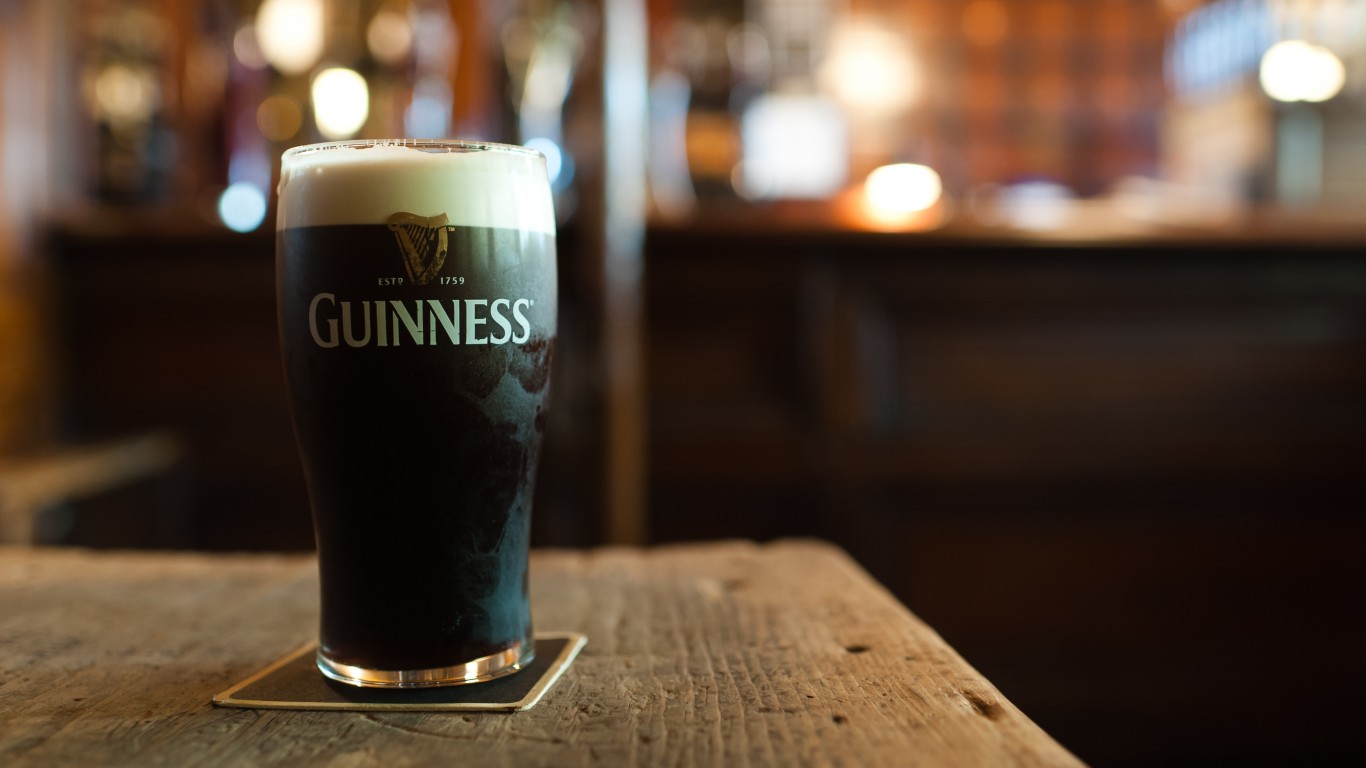
24. Guinness
> Parent company: Diageo
> Barrels shipped in 2019: 1.2 million
> Shipment change from 2018: 8.1%
> Market share: 0.58%
Most of the top-selling imported beers in America are Mexican in origin, but this iconic Irish brand is an exception — and you can count on sales to particular soar around this time every year, in honor of St. Patrick’s Day. Though the brewery now markets a range of different beers, its reputation rests above all on its rich, dark, original stout.
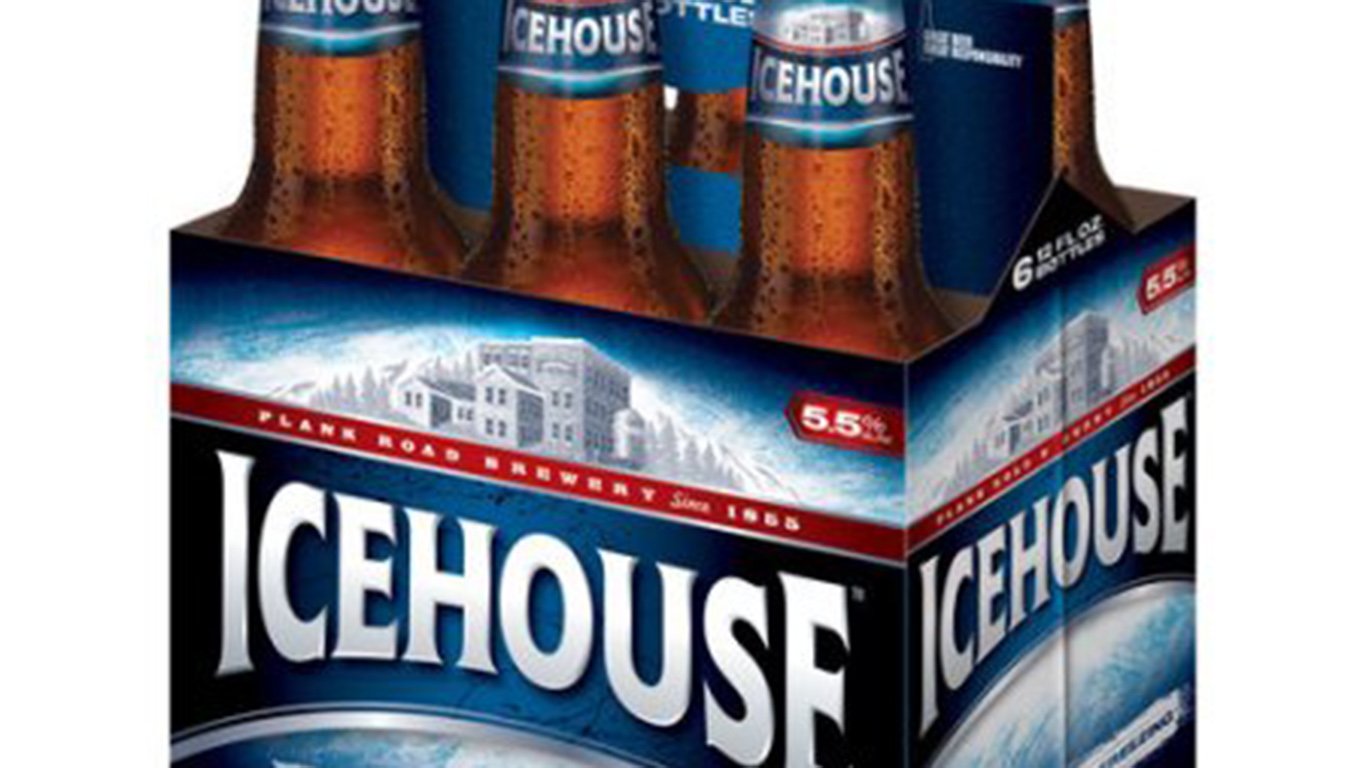
23. Icehouse
> Parent company: Molson Coors Brewing Company
> Barrels shipped in 2019: 1.3 million
> Shipment change from 2018: 1.2%
> Market share: 0.63%
Two Canadian companies, Molson and Labatt, made the first ice beers back in 1993, and Molson Ice, first to be imported into the U.S. that same year, introduced the category to American beer-drinkers. Unlike that offering, the same company’s Icehouse is brewed in the U.S. — in Wisconsin — by the Miller Brewing Company, now part of the Molson Coors family. Icehouse can claim to have been the first domestic ice beer.
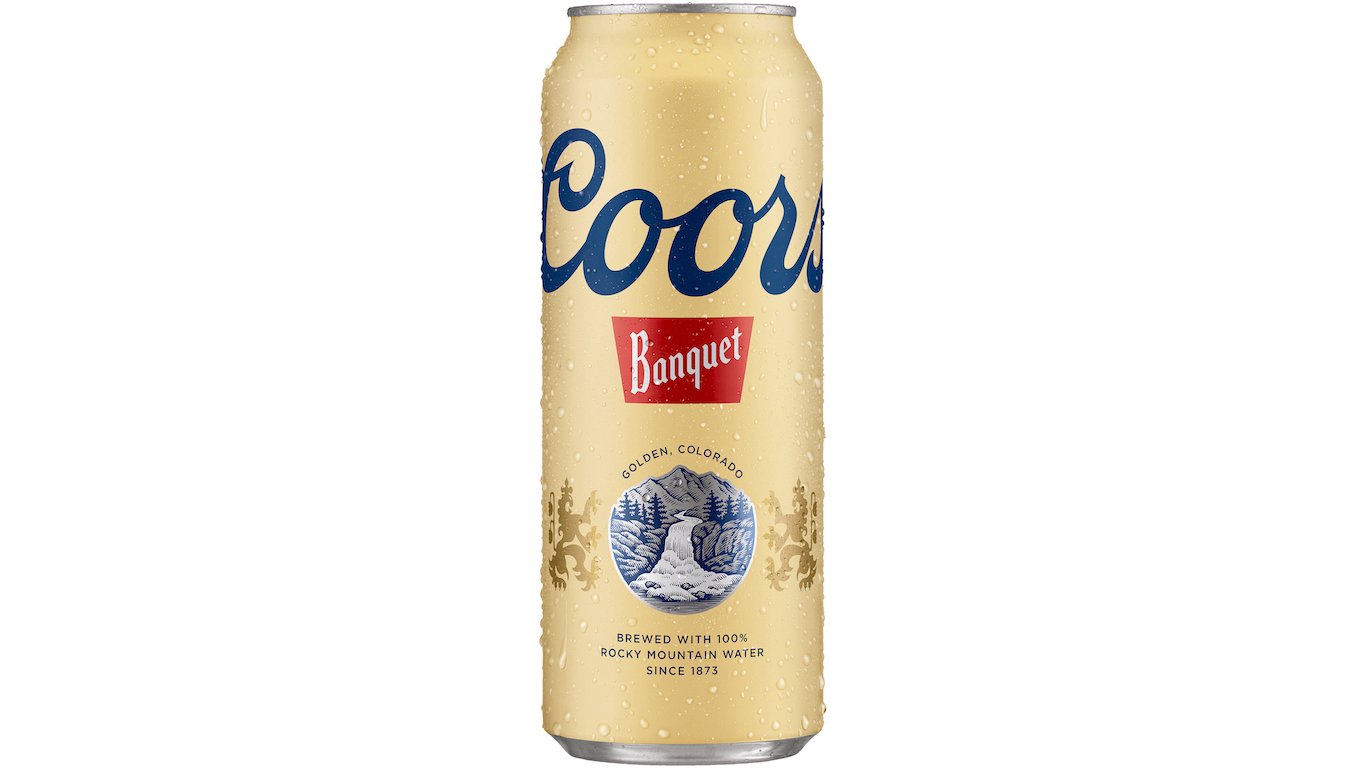
22. Coors Banquet
> Parent company: Molson Coors Brewing Company
> Barrels shipped in 2019: 1.5 million
> Shipment change from 2018: -1.6%
> Market share: 0.74%
Despite its official name, this is just plain old Coors, long something of a cult beer because it was available only in Colorado and points west. Still brewed in Colorado, Coors Banquet is said to have been named in honor of the hearty feasts local miners ate — no doubt accompanied by a flagon or two of suds — when their workday was over.
[in-text-ad-2]
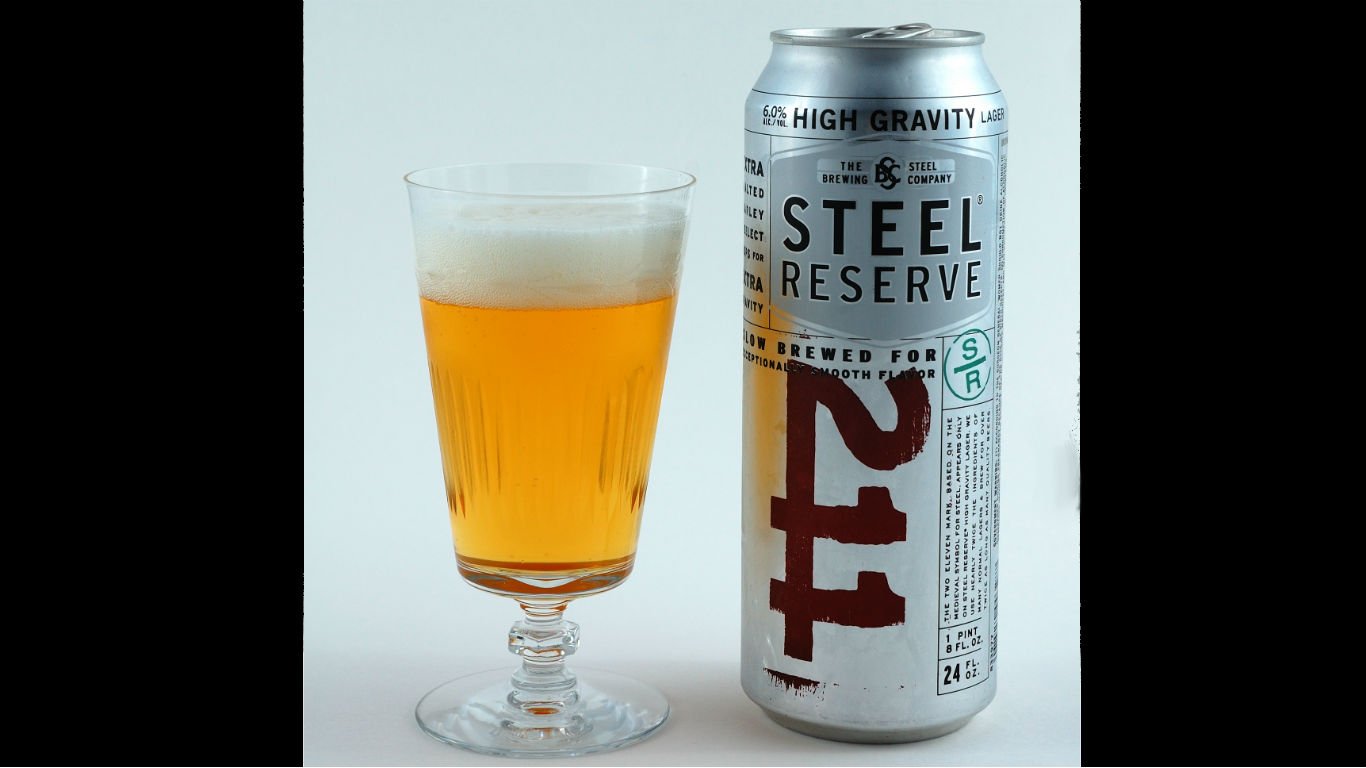
21. Steel Reserve
> Parent company: Molson Coors Brewing Company
> Barrels shipped in 2019: 1.6 million
> Shipment change from 2018: -2.2%
> Market share: 0.75%
Classified as malt liquor — a category that’s higher in alcohol than ordinary beer and usually a bit sweeter (this one measures 8.1% ABV) Steel Reserve was originally known for two versions of its brew. Today, though, it concentrates on its Alloy Series (in cans) — malt liquors with names like Spiked Tropic Storm and Hard Pineapple. In 2013, Steel Reserve received the dubious honor of being named the second most prominent beverage behind alcohol-related emergency room visits (Budweiser came in first).
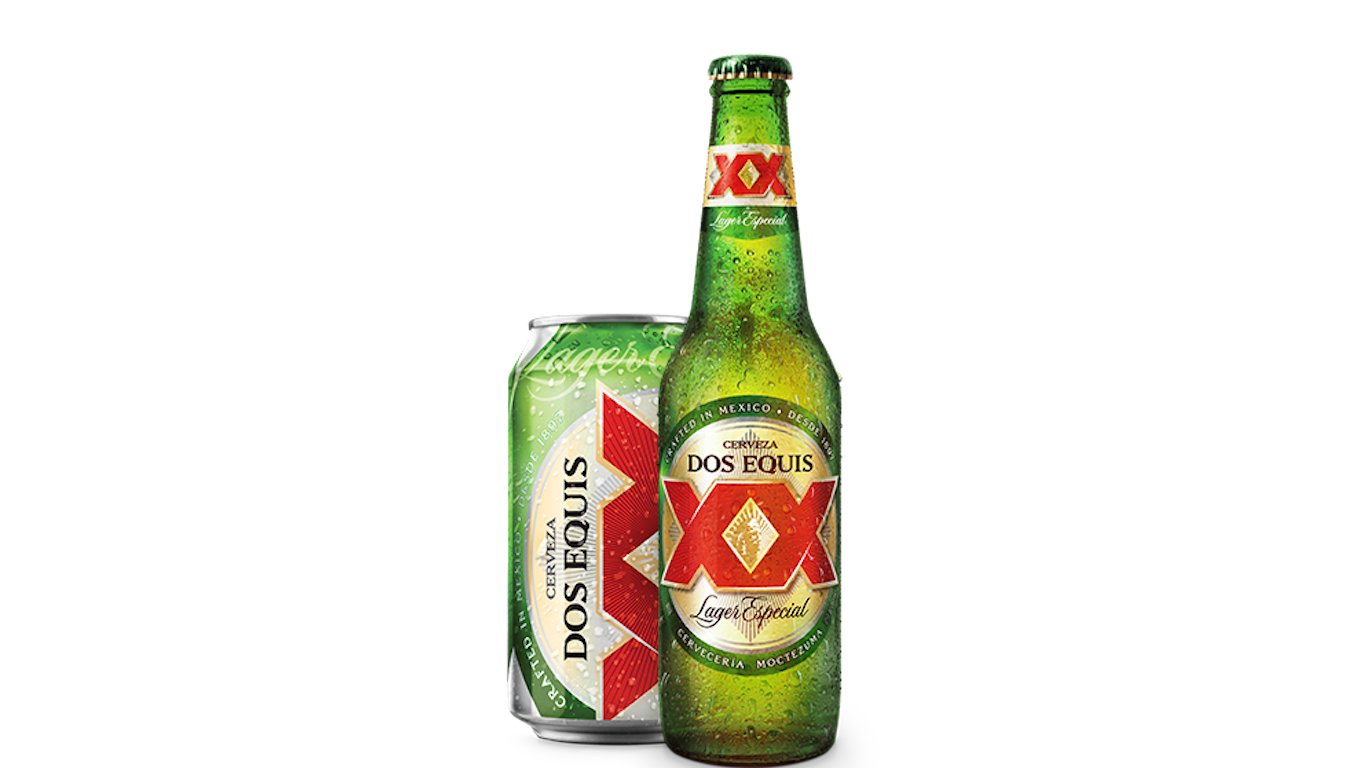
20. Dos Equis
> Parent company: Heineken International
> Barrels shipped in 2019: 1.9 million
> Shipment change from 2018: -2.6%
> Market share: 0.90%
German master brewer Wilhelm Haase created this beer in Veracruz in 1897. An emblematic Mexican brand, it was dubbed “Dos Equis” — “two x’s” — representing the number 20 in Roman numerals, a reference to the impending 20th century. The beer is not just one of the best selling in America, perhaps due at least in part to the brand’s long-running campaign featuring “The Most Interesting Man in the World.”
[in-text-ad]

19. Blue Moon
> Parent company: Molson Coors Brewing Company
> Barrels shipped in 2019: 2.0 million
> Shipment change from 2018: -3.9%
> Market share: 0.96%
Is this a craft beer or not? This reasonably potent Belgian-style white beer (5.4% ABV), flavored with Valencia orange peel, describes itself as “the #1 craft beer in the US,” citing Nielsen data to back up the claim. Because it was created by the head brewmaster at a Coors brewing facility in Denver and is owned by the massive Molson Coors company today, the Brewers Association has objected to its so-called craft identification.
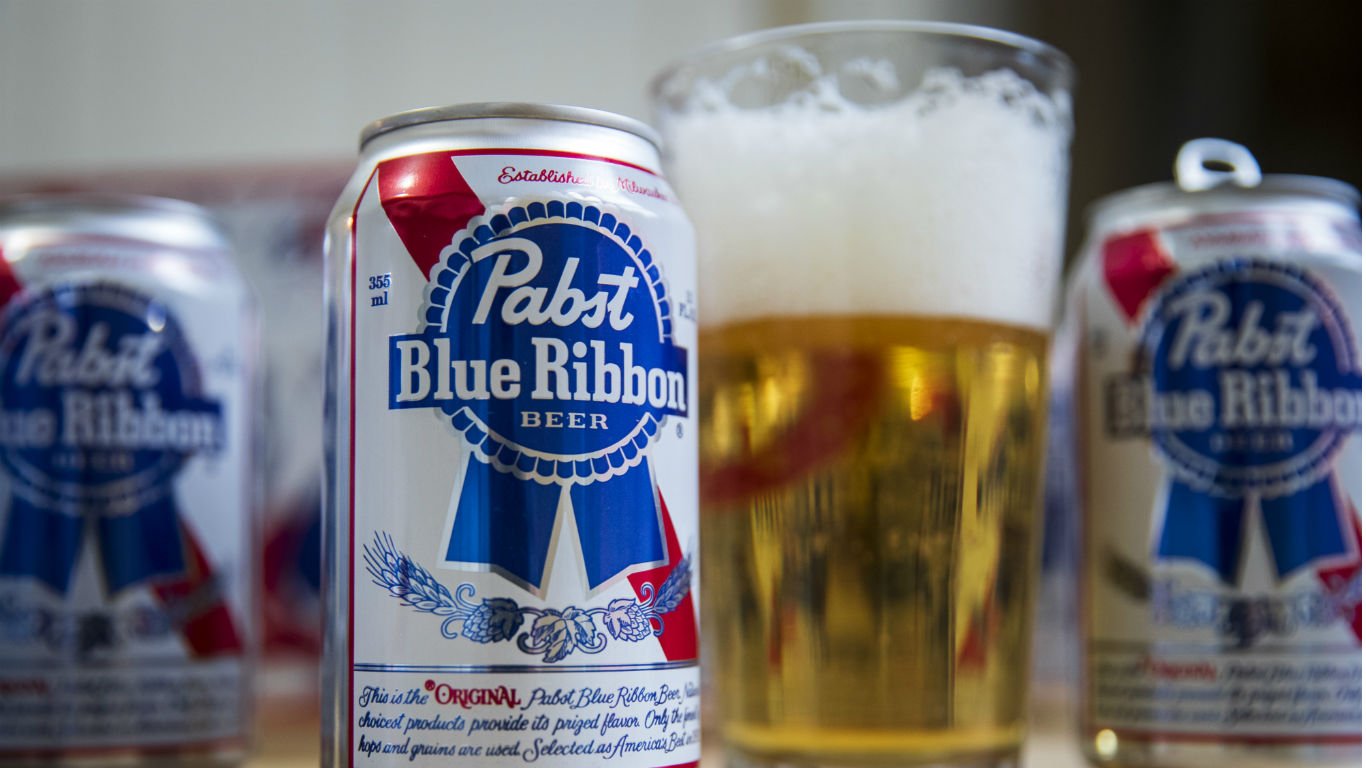
18. Pabst Blue Ribbon
> Parent company: Blue Ribbon Intermediate Holdings
> Barrels shipped in 2019: 2.0 million
> Shipment change from 2018: -10.5%
> Market share: 0.97%
Its famous slogan — “What’ll you have? Pabst Blue Ribbon” — was once ubiquitous in America’s taverns. In the face of new competition, however, it began losing market share in the late 1970s and early ’80s, and the original Pabst brewery in Milwaukee closed down in 1996. The company went through changes of ownership, but gradually revived, and today PBR, as everybody calls it, is considered the definitive hipster beer — inexpensive and easily drinkable. Interestingly, though it is an independent brand, it is brewed by Molson Coors.
17. Yuengling Lager
> Parent company: D.G. Yuengling & Son, Inc.
> Barrels shipped in 2019: 2.0 million
> Shipment change from 2018: -4.7%
> Market share: 1.00%
This Pennsylvania institution is the oldest brewery in America and one of the few major U.S. beer producers that is still family owned. Because it is independently owned and ships fewer than 6 million barrels a year, it is considered a craft brewery, and the Brewers Association ranks it as the nation’s top example in terms of sales volume. Its sales figures are particularly impressive considering that it is distributed only on the East Coast and in the South.
[in-text-ad-2]
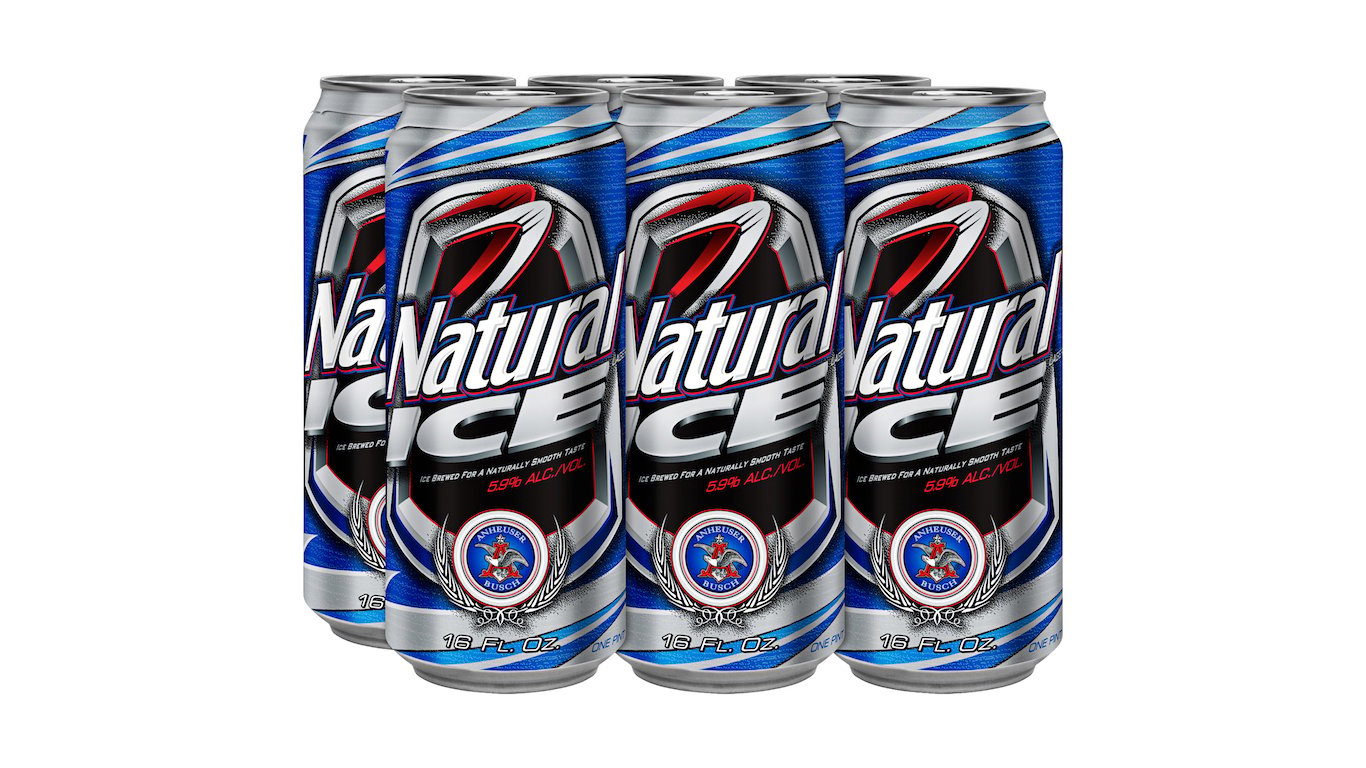
16. Natural Ice
> Parent company: Anheuser-Busch InBev
> Barrels shipped in 2019: 2.2 million
> Shipment change from 2018: -4.3%
> Market share: 1.07%
“Natty” — Natural Light — is one of the top 10 beer brands in America (see No. 8). While its ice-beer sibling has lost some traction in recent years, it remains the nation’s second-most popular ice beer. Like other examples of the genre, it packs more of a punch than its regular counterpart — in this case coming in with an ABV of 5.9%, compared with Natty’s 4.2%.
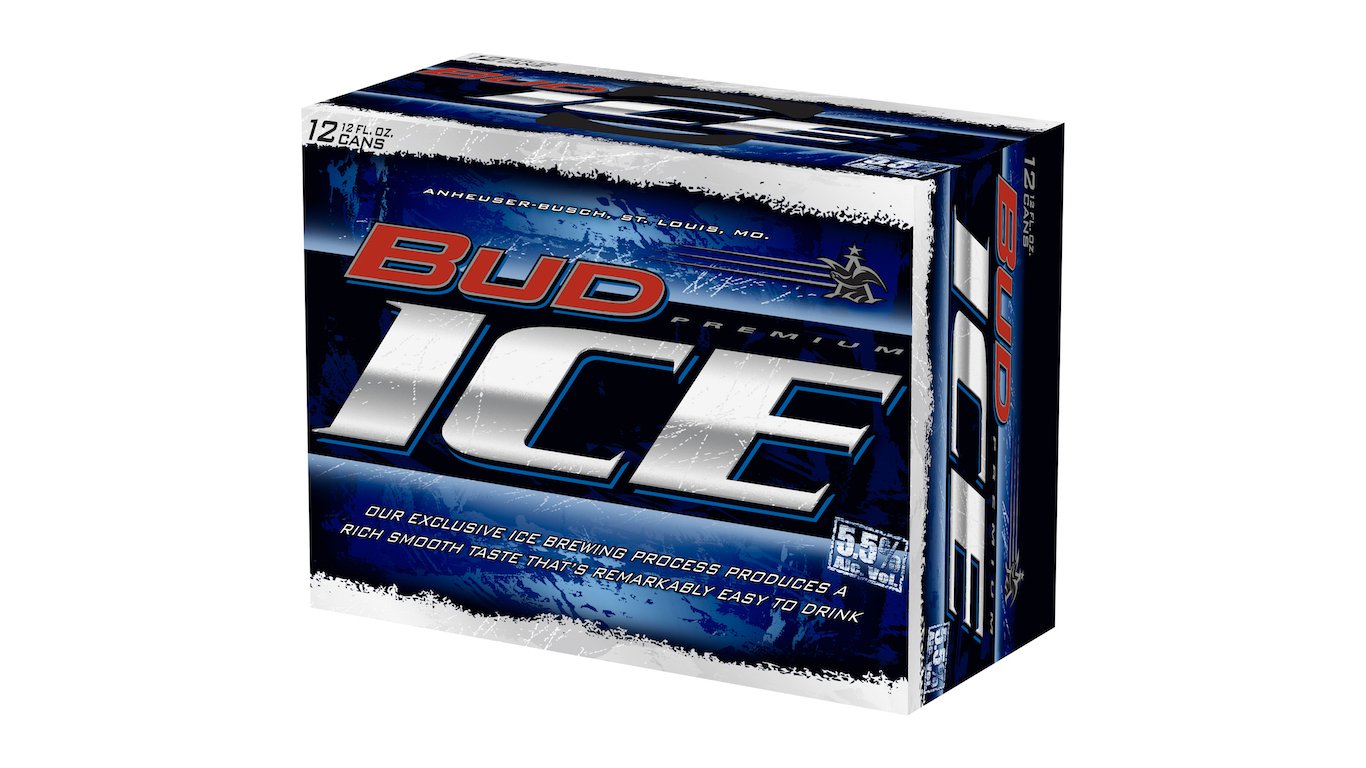
15. Bud Ice
> Parent company: Anheuser-Busch InBev
> Barrels shipped in 2019: 2.4 million
> Shipment change from 2018: -3.0%
> Market share: 1.18%
This smooth, ice-brewed beer was on a roll for a while, with shipments growing more than 17% between 2013 and 2018, but last year shipments declined. It has an ABV of 5.5% and only 123 calories per 12-ounce bottle, slightly lower than the usual. Reviews describe it as “inoffensive cheap ice lager” and “a beer you can drink with buddies while watching a football game on TV.”
[in-text-ad]
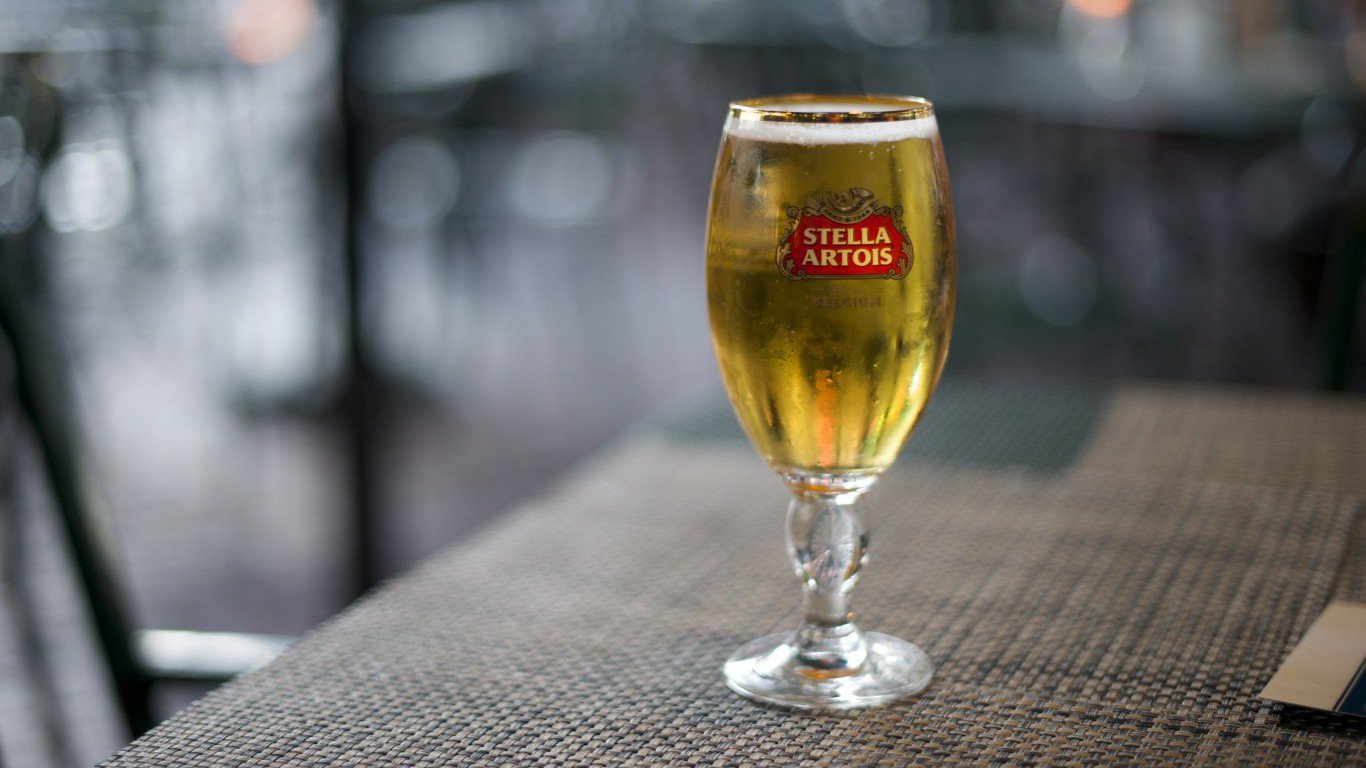
14. Stella Artois
> Parent company: Anheuser-Busch InBev
> Barrels shipped in 2019: 2.7 million
> Shipment change from 2018: -0.9%
> Market share: 1.29%
Praised for its consistency and considered to be of high quality for mass-produced beer, this classic Belgian lager was the third-fastest growing major beer brand in America in the 2010s, recording an increase in sales of more than 90.8% between 2012 and 2017. In 2019, however, shipments slightly declined.
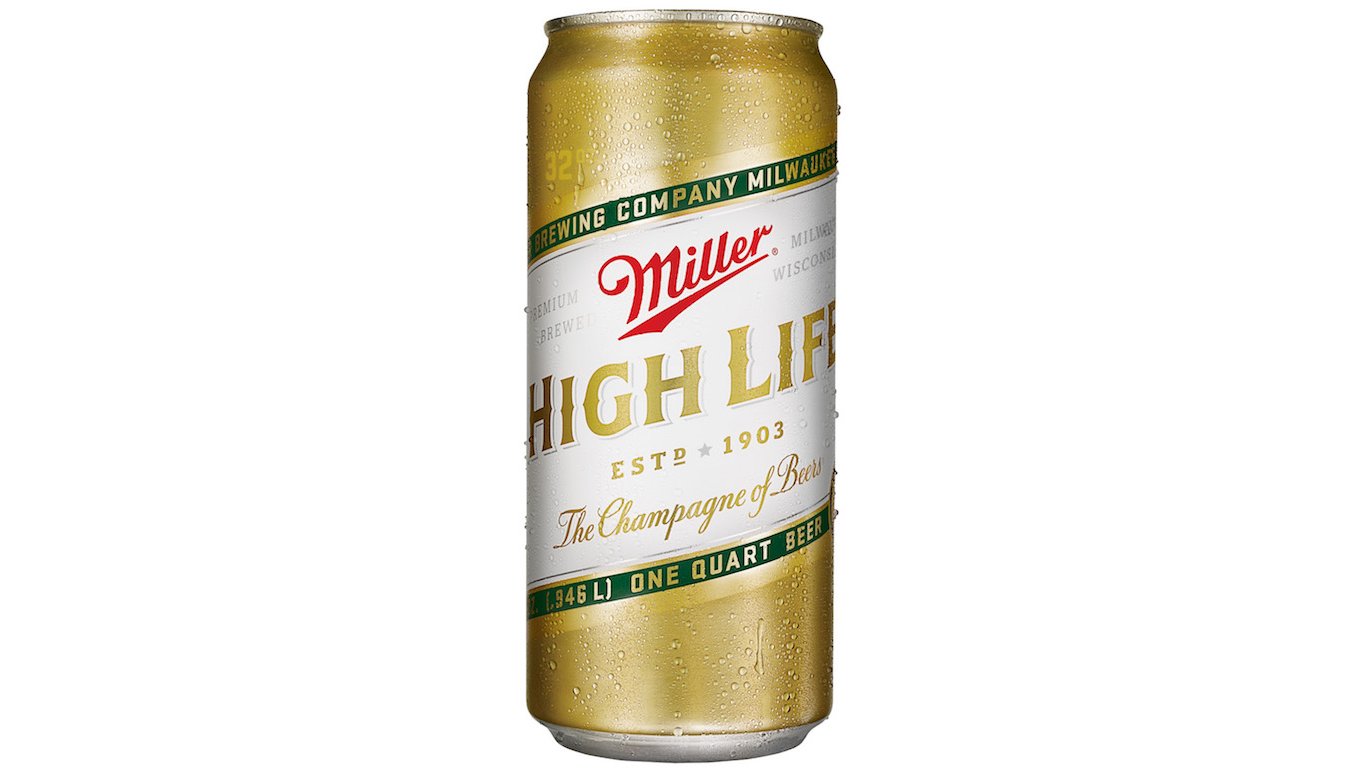
13. Miller High Life
> Parent company: Molson Coors Brewing Company
> Barrels shipped in 2019: 3.0 million
> Shipment change from 2018: -11.8%
> Market share: 1.46%
This pilsner-style beer, created in 1903, was one of the first widely distributed bottled beers in America (though it’s now sold in cans as well). Brewer Frederick Miller called it “High Life,” it is said, because he believed that good living should be available even to those who could only afford beer. He dubbed it “The Champagne of Beers” as a reference to its supposed luxurious quality.
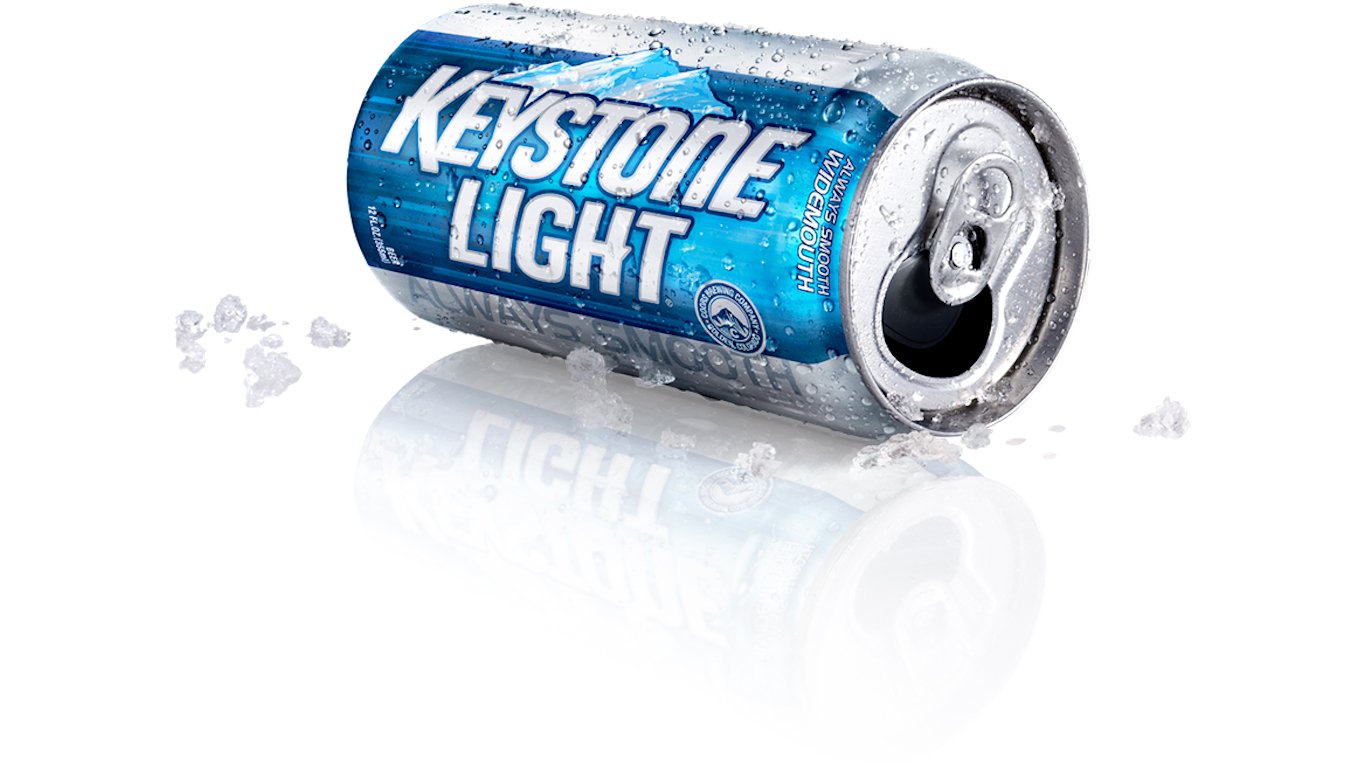
12. Keystone Light
> Parent company: Molson Coors Brewing Company
> Barrels shipped in 2019: 3.3 million
> Shipment change from 2018: -7.1%
> Market share: 1.60%
This triple-filtered light lager, brewed by Coors in Colorado, comes in at 104 calories per 12-ounce bottles — six fewer than industry sales leader Bud Light (see No. 1). First brewed in 1989, Keystone Light has been dismissed as “beer-flavored water.”
[in-text-ad-2]
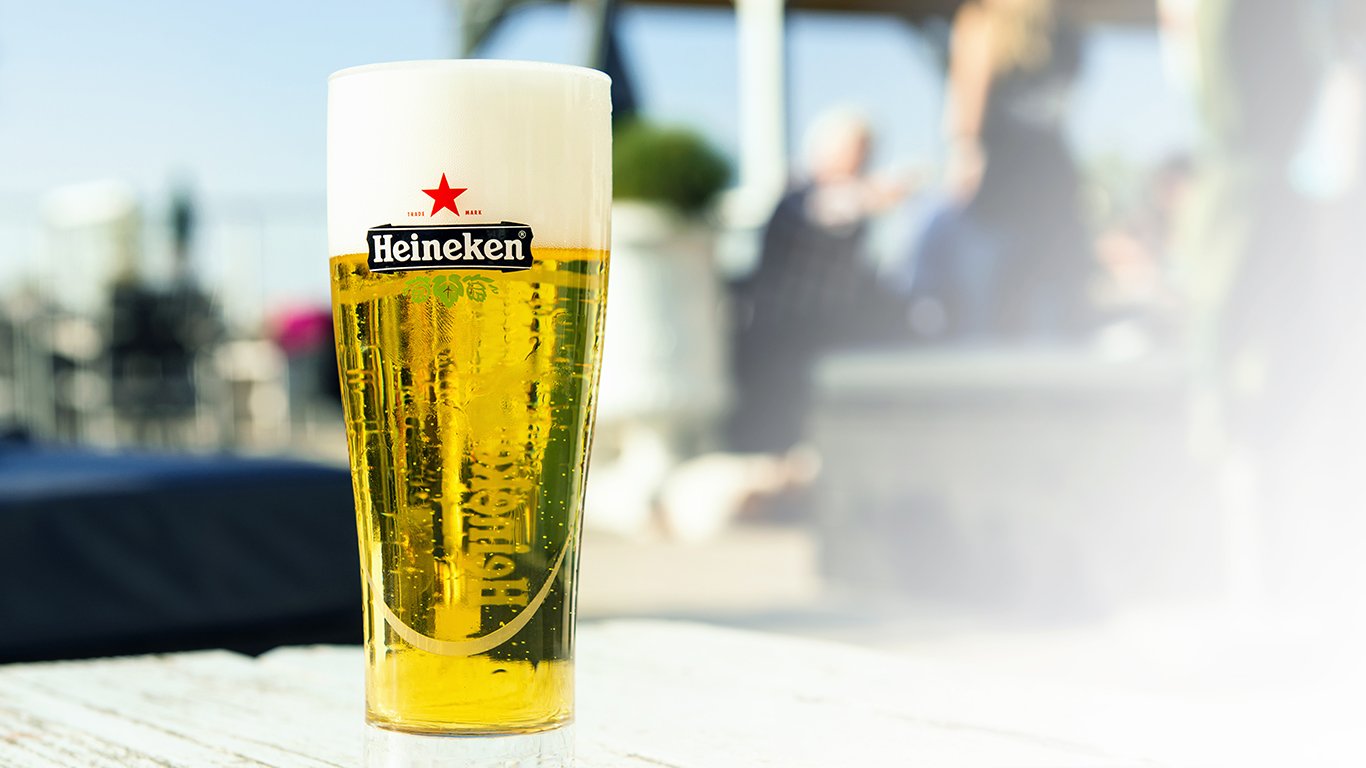
11. Heineken
> Parent company: Heineken International
> Barrels shipped in 2019: 3.7 million
> Shipment change from 2018: -3.9%
> Market share: 1.78%
Brewed in the Netherlands for more than 150 years, Heineken is one of the world’s most recognizable and widely distributed beer brands — and one of the most popular lagers in the beer universe. It is also America’s third-most popular imported beer and the most popular European brew.
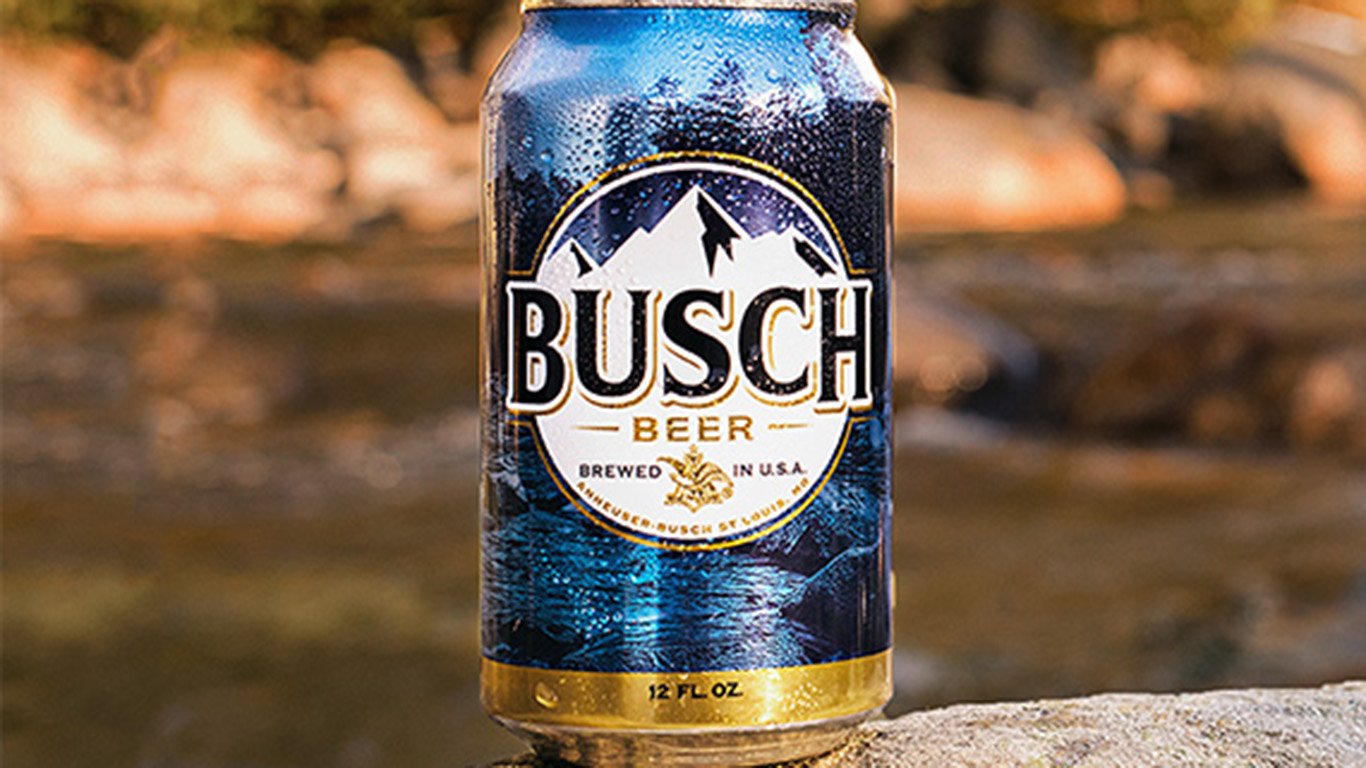
10. Busch
> Parent company: Anheuser-Busch InBev
> Barrels shipped in 2019: 3.9 million
> Shipment change from 2018: -7.8%
> Market share: 1.87%
Formerly sold under the name Busch Bavarian Beer, this was the first brew Anheuser-Busch marketed after Prohibition — though it took the company a long time. Prohibition was repealed in 1933, and the beer didn’t appear until 22 years later. Busch bills itself as being “as crisp and cold as a mountain stream” — a claim echoed by the snowy peaks depicted on the label.
[in-text-ad]
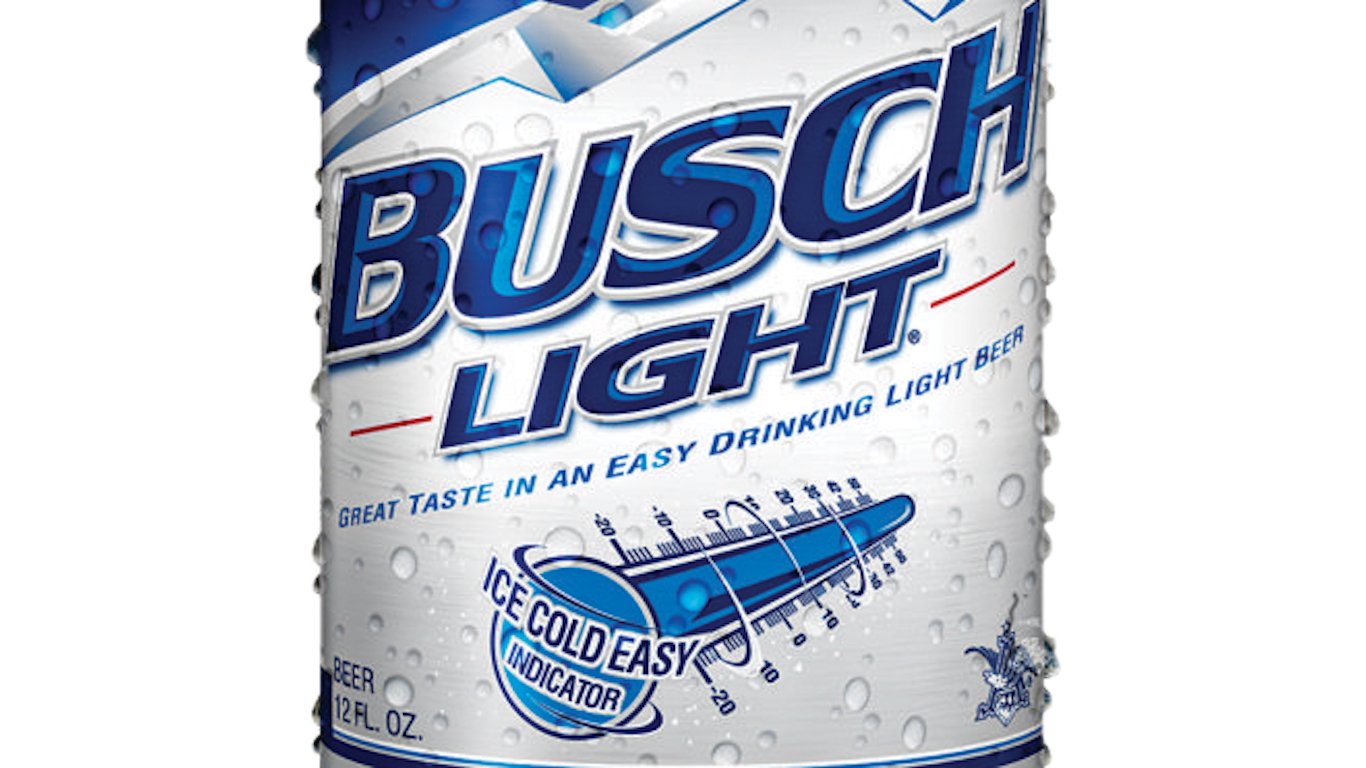
9. Busch Light
> Parent company: Anheuser-Busch InBev
> Barrels shipped in 2019: 6.3 million
> Shipment change from 2018: 1.6%
> Market share: 3.07%
A lighter sibling of the original Busch, this light beer has only a slightly lower ABV than the standard Busch (4.1% versus 4.3%). It earns its “light” designation, though, by having a mere 95 calories per 12-ounce can (19 fewer than regular Busch) and 3.2 grams of carbohydrates (roughly half what its near-namesake has).

8. Natural Light
> Parent company: Anheuser-Busch InBev
> Barrels shipped in 2019: 6.7 million
> Shipment change from 2018: -0.7%
> Market share: 3.24%
“Natty” bills itself as “the official beer of keeping it real and letting things just happen.” A light pilsner, it has the same calorie count as another Anheuser-Busch light brand, Busch Light — 95 — and 35 fewer calories than Natural Ice (see No. 16).
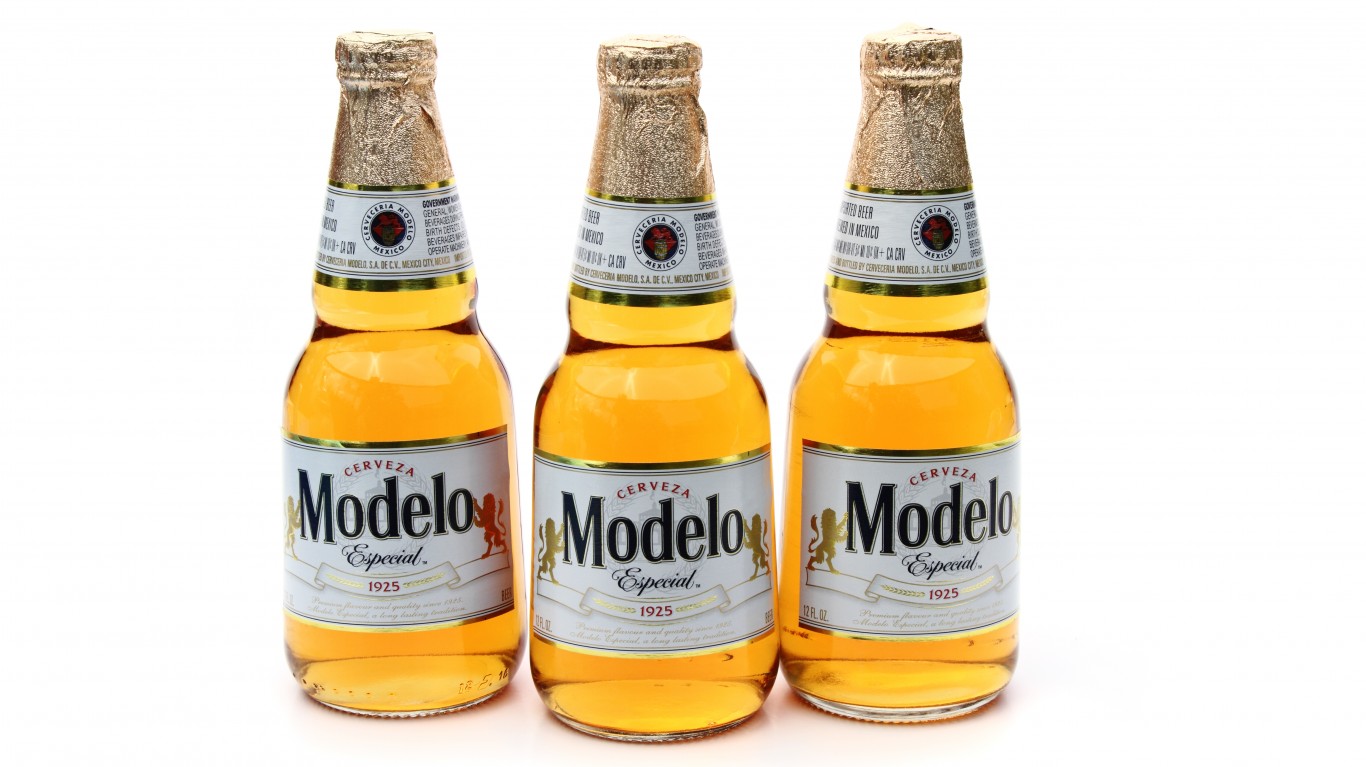
7. Modelo Especial
> Parent company: Constellation Brands
> Barrels shipped in 2019: 9.4 million
> Shipment change from 2018: 15.0%
> Market share: 4.56%
America’s second-most popular Mexican beer, Modelo Especial is a rich, pilsner-style lager. It has a darker, richer lager cousin, Negra Modelo, made in the centuries-old Munich Dunkel (dark) style. It has a following of its own, but its sales are substantially lower.
[in-text-ad-2]
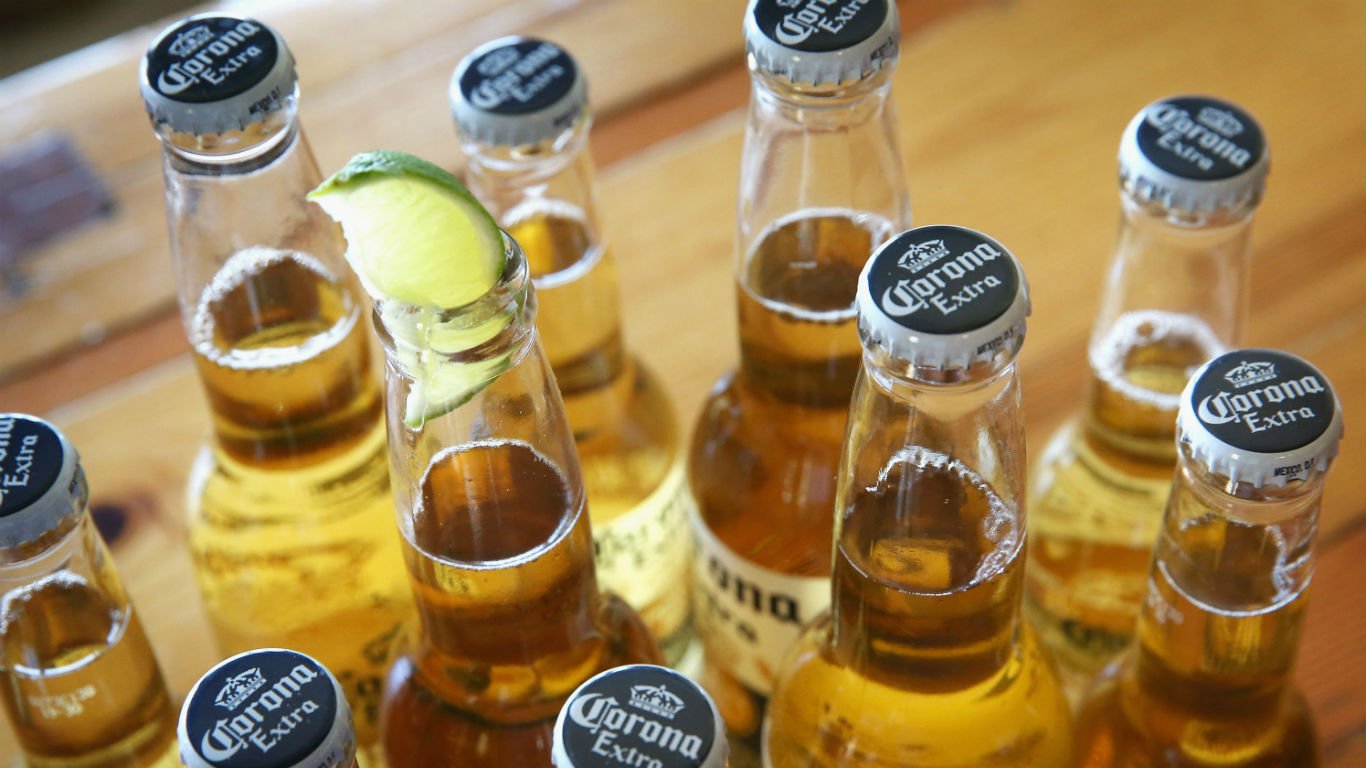
6. Corona Extra
> Parent company: Constellation Brands
> Barrels shipped in 2019: 8.1 million
> Shipment change from 2018: -0.5%
> Market share: 3.95%
First brewed in 1925, Corona didn’t cross the border until 1981 — but it became America’s favorite Mexican beer, and the nation’s No. 1 beer import of any kind. There have been reports that Corona sales are down in the U.S. because — ridiculously — people somehow associate it with the coronavirus. According to Corona’s parent company, however, American sales actually grew 5% in the four-week period ending Feb. 16.

5. Michelob Ultra
> Parent company: Anheuser-Busch InBev
> Barrels shipped in 2019: 10.2 million
> Shipment change from 2018: 15.9%
> Market share: 4.97%
This is a good light beer for those on a low-carb diet: It measures only 2.6 grams of carbohydrates per 12-ounce bottle, making it the beer with fifth lowest carbs on the market and the only one of the five that qualifies for this list. It’s low in calories, too, with a mere 95.
[in-text-ad]
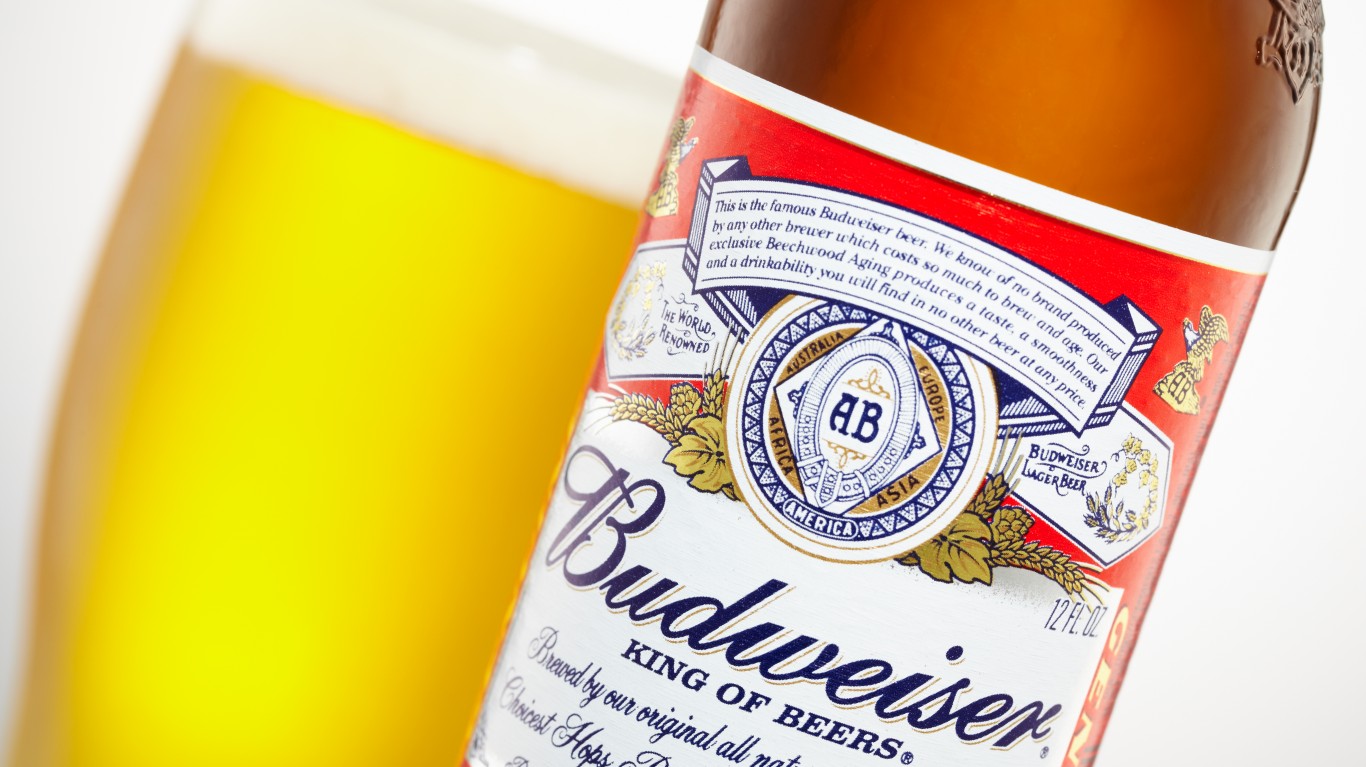
4. Budweiser
> Parent company: Anheuser-Busch InBev
> Barrels shipped in 2019: 10.6 million
> Shipment change from 2018: -6.6%
> Market share: 5.14%
Bud is America’s best-selling full-strength beer (as opposed to light offerings). It’s brewed in a process called kraeusening, meaning it is carbonated with actively fermenting beer, which is said to shorten the carbonation process and help remove off-flavors. During this process, brewers add treated beechwood strips to attract yeast. This is the source of Bud’s famous “beechwood aging” slogan.
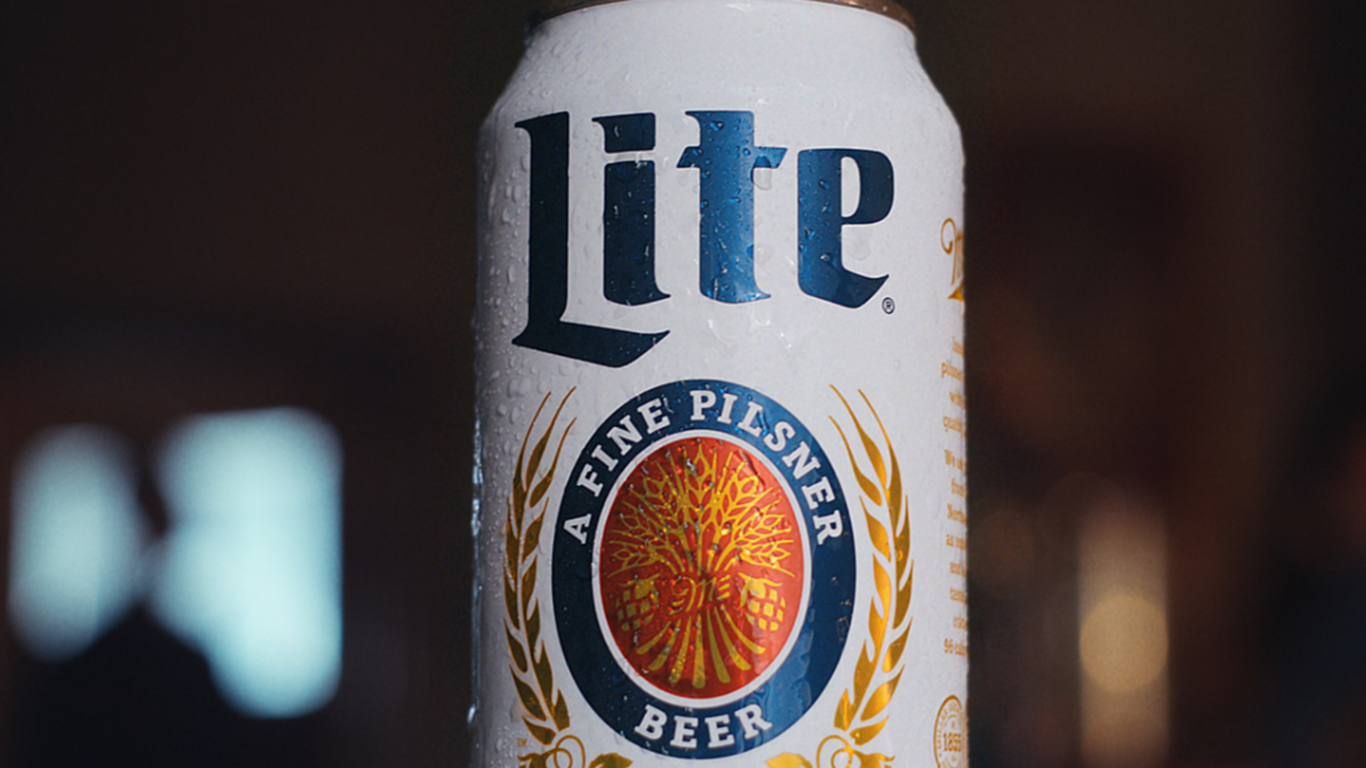
3. Miller Lite
> Parent company: Molson Coors Brewing Company
> Barrels shipped in 2019: 12.4 million
> Shipment change from 2018: -1.6%
> Market share: 6.02%
The folks at Molson Coors call this “the original light beer.” Well, sort of. Reduced-calorie beer was first developed in 1967 by the Rheingold Brewing Company. The once dominant brand in the New York market was bought by Miller in 1972. The company reformulated the beer and released it as Miller Lite in 1975. The brand’s iconic “Tastes great! / Less filling!” TV campaign, featuring retired sports figures and other celebrities, is credited with helping popularize the beer.
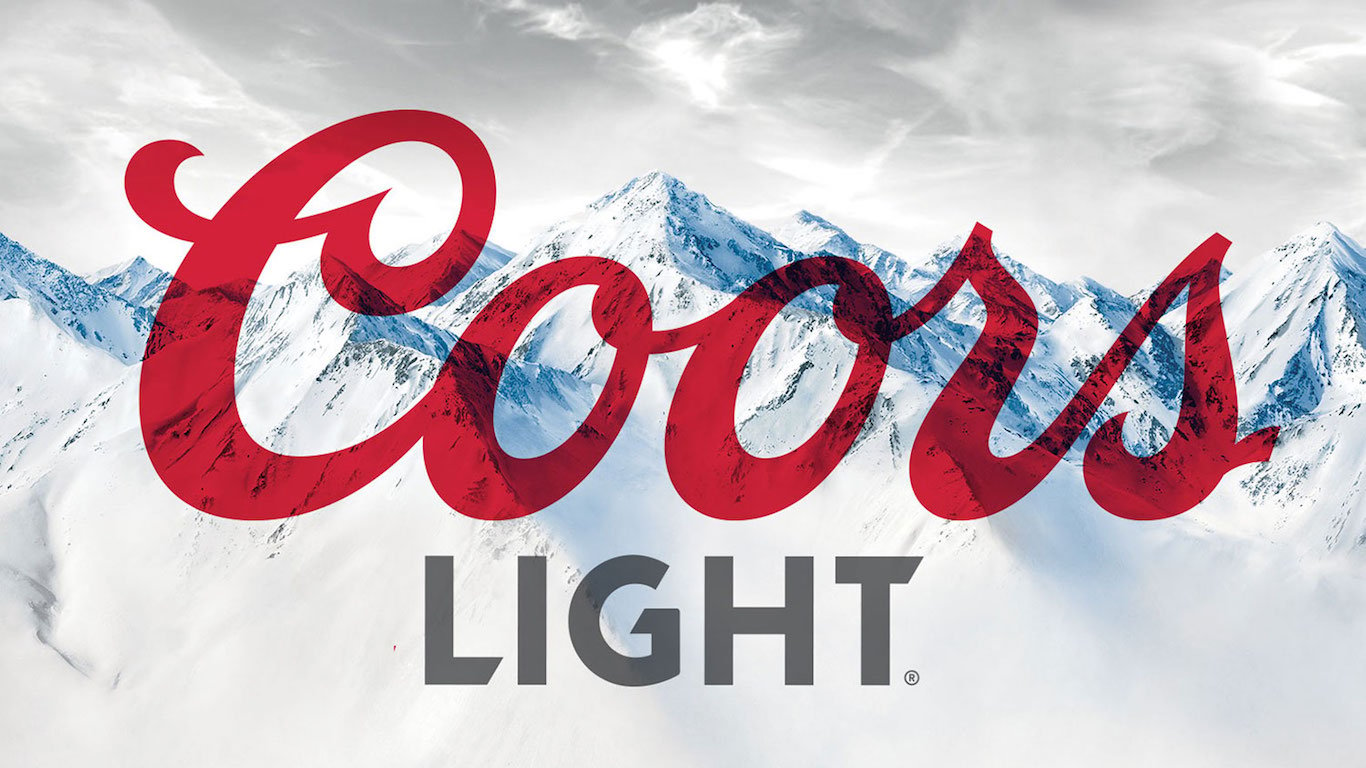
2. Coors Light
> Parent company: Molson Coors Brewing Company
> Barrels shipped in 2019: 14.0 million
> Shipment change from 2018: -5.9%
> Market share: 6.82%
Beer reviewers don’t tend to think much of the low-cal, low-carb lager, but a good many drinkers — obviously — enjoy it, probably for its light, clean flavor and the ease with which it goes down. It’s hardly the best beer for the truly diet-conscious, however. There are at least a dozen other beers with fewer carbs, and at least 14 others with fewer calories.
[in-text-ad-2]

1. Bud Light
> Parent company: Anheuser-Busch InBev
> Barrels shipped in 2019: 27.2 million
> Shipment change from 2018: -7.3%
> Market share: 13.24%
This light lager has an “Awful” rating and an overall score of 45/100 from BeerAdvocate. That hasn’t stopped fans from making it America’s best-selling beer by a margin of almost two-to-one compared to its next closest competitor. Its market dominance is slipping though: Sales were down 20.7% between 2013 and 2018, and they dropped another 7.3% in 2019. The brand stirred controversy when it introduced its “no corn syrup” campaign in its 2019 Super Bowl ads, which insinuated that rivals Miller Lite and Coors Light contained the sweetener. Last fall, a federal judge issued an injunction barring Anheuser-Busch from making its corn syrup claims.
Detailed findings & methodology:
24/7 Tempo reviewed domestic shipping volume data provided by industry advocacy group Beer Marketer’s Insights to determine America’s biggest beer brands in terms of 2019 sales volume.
As impressive as the sales figures for the big beer brands can be, there is some evidence that we may be losing our affection for beer, at least a little. “Beer is in a bear market,” reported CNN Business in December, in an article titled “Beer is slipping: Here’s what Americans are drinking instead.”
What Americans are drinking instead, according to CNN’s Jordan Valinsky, is “a variety of other boozy drinks, including premium liquor, canned wine, spiked seltzers and pre-made bottled cocktails.” Sales of domestic beer specifically, he added, declined 4.6% between October 2018 and the same month in 2019. Perhaps even more surprising is the fact that, according to the data and consumer engagement platform BeerBoard, Americans drank 1.3% less beer on Super Bowl Sunday — a beer-drinking occasion if ever there was one — this year than we did in 2019.
Despite this downturn, beer isn’t going away any time soon. A Gallup poll released last summer revealed that among Americans who drink alcohol, some 38% of all drinkers — and 55% of
men — prefer beer to wine or liquor. (This is how much beer the average person drank in every state last year.) And as the numbers prove, when we drink beer, these 25 account for most of it.
Are You Ahead, or Behind on Retirement? (sponsor)
If you’re one of the over 4 Million Americans set to retire this year, you may want to pay attention.
Finding a financial advisor who puts your interest first can be the difference between a rich retirement and barely getting by, and today it’s easier than ever. SmartAsset’s free tool matches you with up to three fiduciary financial advisors that serve your area in minutes. Each advisor has been carefully vetted, and must act in your best interests. Start your search now.
Don’t waste another minute; get started right here and help your retirement dreams become a retirement reality.
Thank you for reading! Have some feedback for us?
Contact the 24/7 Wall St. editorial team.
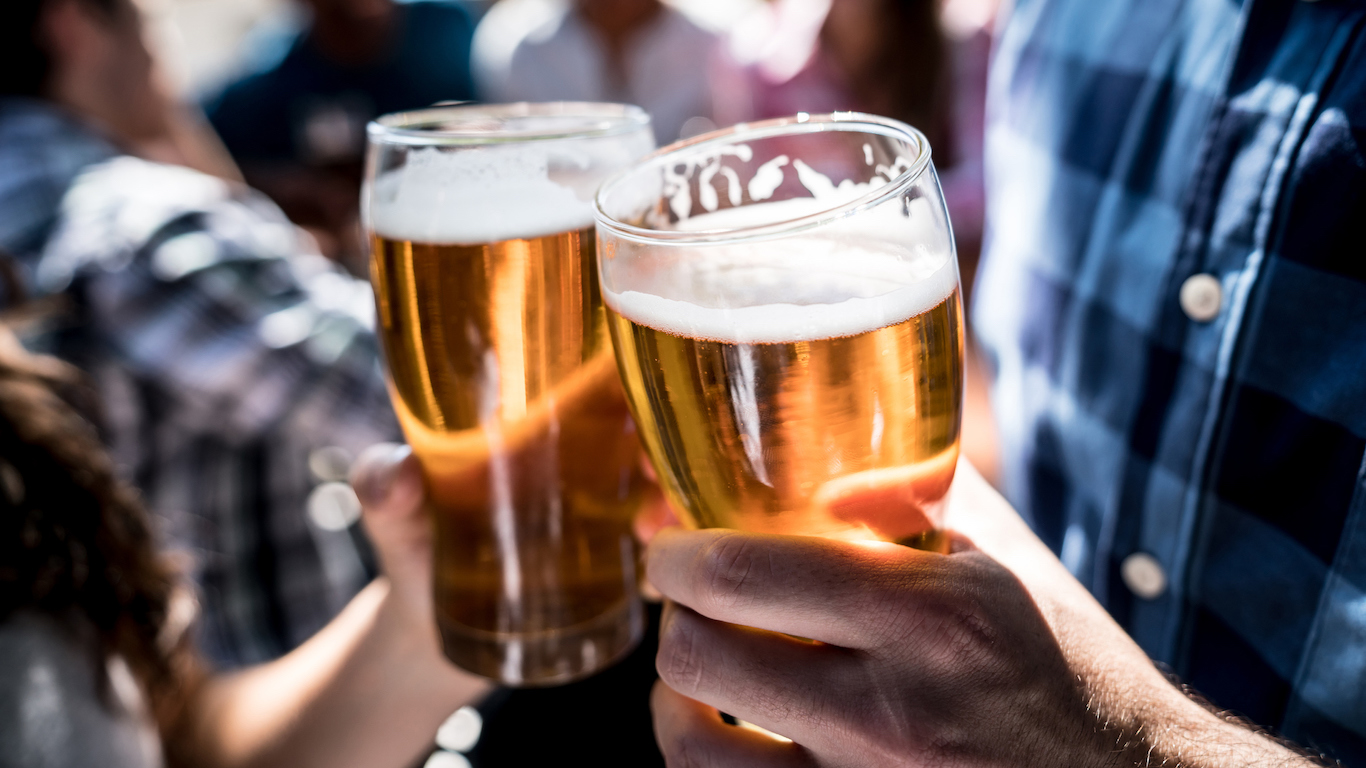 24/7 Wall St.
24/7 Wall St.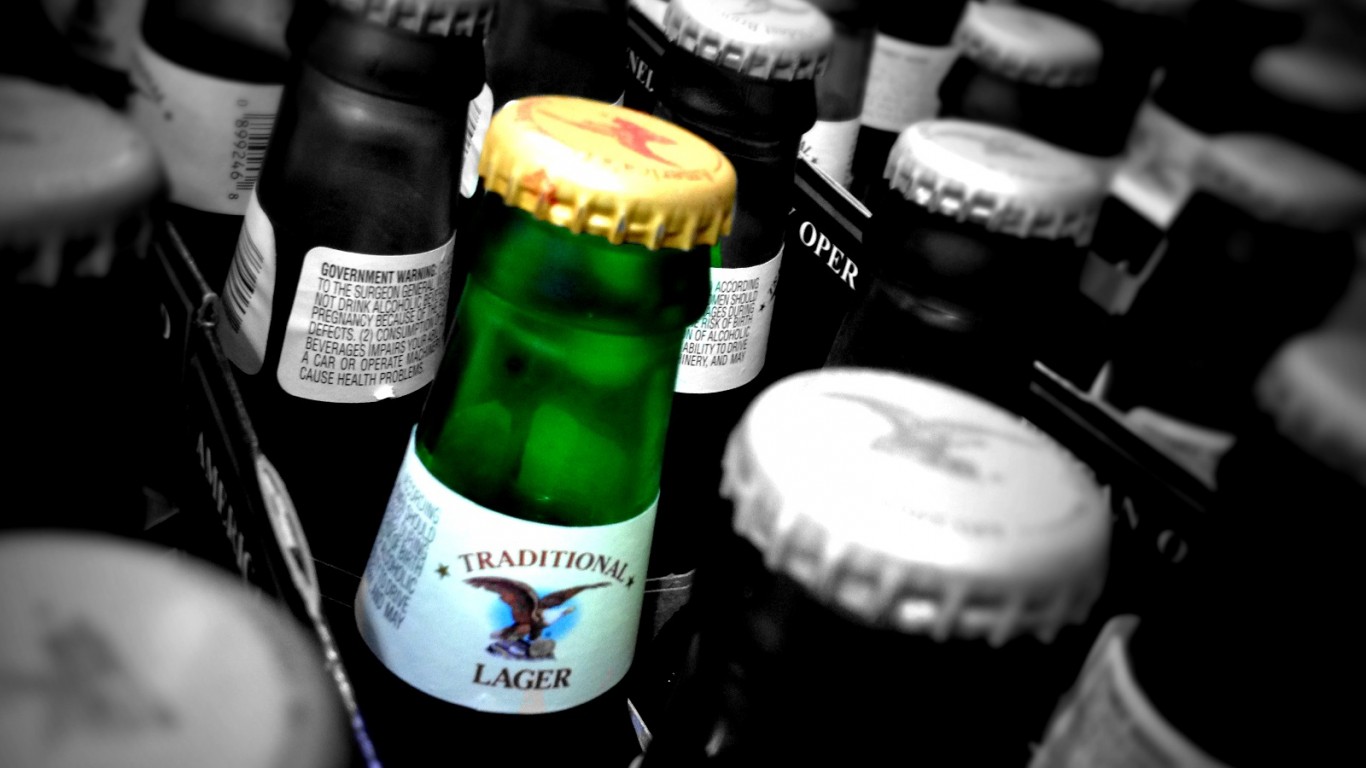
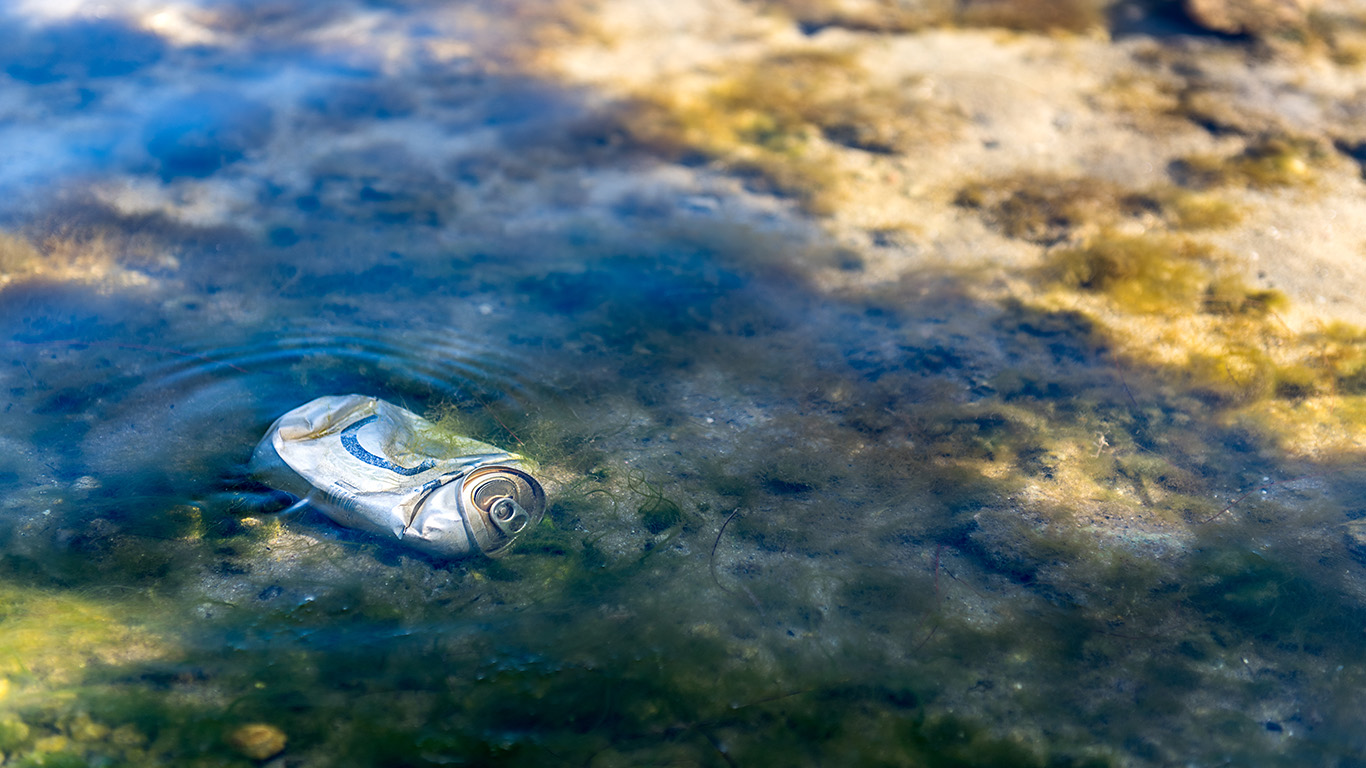 24/7 Wall St.
24/7 Wall St.

